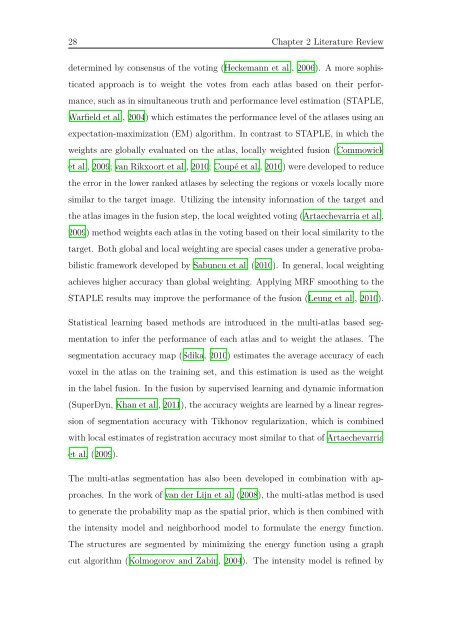Docteur de l'université Automatic Segmentation and Shape Analysis ...
Docteur de l'université Automatic Segmentation and Shape Analysis ...
Docteur de l'université Automatic Segmentation and Shape Analysis ...
Create successful ePaper yourself
Turn your PDF publications into a flip-book with our unique Google optimized e-Paper software.
28 Chapter 2 Literature Review<br />
<strong>de</strong>termined by consensus of the voting (Heckemann et al., 2006). A more sophis-<br />
ticated approach is to weight the votes from each atlas based on their perfor-<br />
mance, such as in simultaneous truth <strong>and</strong> performance level estimation (STAPLE,<br />
Warfield et al., 2004) which estimates the performance level of the atlases using an<br />
expectation-maximization (EM) algorithm. In contrast to STAPLE, in which the<br />
weights are globally evaluated on the atlas, locally weighted fusion (Commowick<br />
et al., 2009; van Rikxoort et al., 2010; Coupé et al., 2010) were <strong>de</strong>veloped to reduce<br />
the error in the lower ranked atlases by selecting the regions or voxels locally more<br />
similar to the target image. Utilizing the intensity information of the target <strong>and</strong><br />
the atlas images in the fusion step, the local weighted voting (Artaechevarria et al.,<br />
2009) method weights each atlas in the voting based on their local similarity to the<br />
target. Both global <strong>and</strong> local weighting are special cases un<strong>de</strong>r a generative proba-<br />
bilistic framework <strong>de</strong>veloped by Sabuncu et al. (2010). In general, local weighting<br />
achieves higher accuracy than global weighting. Applying MRF smoothing to the<br />
STAPLE results may improve the performance of the fusion (Leung et al., 2010).<br />
Statistical learning based methods are introduced in the multi-atlas based seg-<br />
mentation to infer the performance of each atlas <strong>and</strong> to weight the atlases. The<br />
segmentation accuracy map (Sdika, 2010) estimates the average accuracy of each<br />
voxel in the atlas on the training set, <strong>and</strong> this estimation is used as the weight<br />
in the label fusion. In the fusion by supervised learning <strong>and</strong> dynamic information<br />
(SuperDyn, Khan et al., 2011), the accuracy weights are learned by a linear regres-<br />
sion of segmentation accuracy with Tikhonov regularization, which is combined<br />
with local estimates of registration accuracy most similar to that of Artaechevarria<br />
et al. (2009).<br />
The multi-atlas segmentation has also been <strong>de</strong>veloped in combination with ap-<br />
proaches. In the work of van <strong>de</strong>r Lijn et al. (2008), the multi-atlas method is used<br />
to generate the probability map as the spatial prior, which is then combined with<br />
the intensity mo<strong>de</strong>l <strong>and</strong> neighborhood mo<strong>de</strong>l to formulate the energy function.<br />
The structures are segmented by minimizing the energy function using a graph<br />
cut algorithm (Kolmogorov <strong>and</strong> Zabin, 2004). The intensity mo<strong>de</strong>l is refined by
















